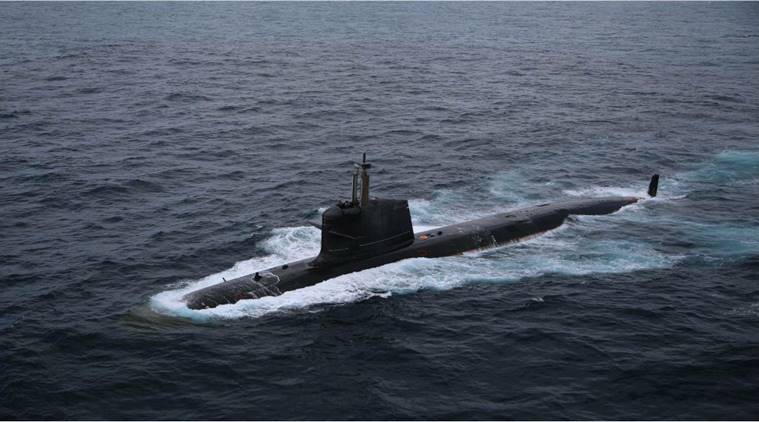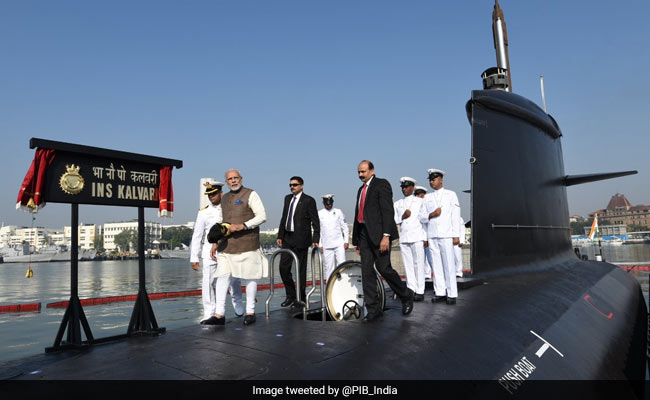By Colonel Awadhesh Kumar , veteran Special Forces
( article was published earlier in JAGRUK BHARAT )
INS CHENNAI was commissioned into Indian Navy on 21 Nov 2016 thus adding more teeth to IN. It also marked the completion of Project 15 A. In the foreseeable future INS VISHAKHAPATNAM and its follow on MORMUGAO, PARADEEP, PORBANDAR, also INS VIKRANT, INS KALVARI, INS ARIDHIMAN, INS KILTAN, and many other ships and submarines will add more teeth, muscle and tail( equally important) to the Navy. Slowly but steadily Indian Navy is moving towards MY DREAM INDIAN NAVY 2040.
However in conjunction with securing the LOC, LAC and IB by smart fencing etc we need to move fast on our Sea Boards too. Our aim must be to secure the Western Sea Board at the earliest. Towards this the major command and control elements are already in place.

Now the Western Coast under the jurisdiction of Western Naval Command already has Flag Officers Commanding Gujarat, Maharashtra, Goa and Karnatka Naval Areas. Thus each of the Coastal State now has a dedicated HQ Naval Area under a Flag Rank Officer — a Rear Admiral responsible for overall Coastal Security apart from looking after the usual Naval business.
A total of over 50 Nodal Hubs are already in place along the Indian Coast for coastal security and are Net worked with the four Joint Operation Centres( JOC), one each at Mumbai, Kochi, Vishakhapatnam and Port Blair ie with each Naval Command.

For Coastal Surveillance we already have a chain of over 45 coastal radars and over74 Automatic Identification System Receivers. For gapless cover a few more of these are coming up in the second phase. An Information Management and Analysis Centre ( IMAG ) is now functional at Gurgaon. Thus the National Command,Control, Communication and Intelligence Network now collects data about all types of vessels operating along or near our Coast.

On any given day over 2000 ships, over 700 Coastal Vessels, more than 900 dhows, 500 barges, 1000 dredgers and 10000s fishing boats are plying within our EEZ. Thus IMAG, JOCs and the Nodes are a major step in our Coastal Security Shield. However these are basically only surveillance measures and just not enough for security of our very porous maritime boundary.
The Western Sea Board has numerous creeks, small bays, rivulets, lagoons, estuaries, swamps, mudflats, sand bars, beaches, small islands including uninhabited ones and even back waters. Many of the Creeks are inter connected and have intricate maze of shallow and deep channels.

Thus the shore line is highly indented and mostly totally unguarded or very poorly guarded. This has been further compounded by the maritime dispute with Pakistan in Kutch area, extensive fishing by medium sized and small sized boats and a huge Dhow based trade with the Middle East.
The heavy traffic of oil tankers in the Gulf of Kutch and Khambhat, SEZs and heavy industrialization on parts of Gujarat coastline all have increased our Coastal Security imperatives. Thus to fully secure our sea coast we have to take the next step that is Offensive Defence. We need to add muscle power and teeth to the existing Coastal Surveillance System.
As a first step Joint Operation Centres must come up under each HQ Naval Areas with its full establishment and all the required assets. This will ensure seem less coordination among all stake holders….Navy, Coast Guard, State Govt including its various agencies and Central Agencies located in the respective States of Gujarat- Daman UT– Diu UT, Maharashtra, Goa and Karnatak — Mahe and also between the JOC of the Naval Area and JOC of HQ Western Naval Command. There are over 15 Agencies and entities / departments which have stake in matters Coastal including Coastal Security.
 Second Step required is creation of few more forward Operating bases. We already have INS DWARKA and INS SARDAR PATEL on Gujarat Coast. To further strengthen our surveillance and interception capabilities we need to develop Forward Operating Bases at Jakhau, Mandovi and Bedi Port and also Operating bases at Mangalore and Bhatkal. Keeping the future expansion of the Navy and Coast Guard, time has also come to explore possibility of creating moderate size ( half of KADAMBA) bases near Hazira, Dahnu and VijayDurg.
Second Step required is creation of few more forward Operating bases. We already have INS DWARKA and INS SARDAR PATEL on Gujarat Coast. To further strengthen our surveillance and interception capabilities we need to develop Forward Operating Bases at Jakhau, Mandovi and Bedi Port and also Operating bases at Mangalore and Bhatkal. Keeping the future expansion of the Navy and Coast Guard, time has also come to explore possibility of creating moderate size ( half of KADAMBA) bases near Hazira, Dahnu and VijayDurg.
Third Step is to establish fully integrated Coastal Missile Defence bases with over lapping arcs so as to cover the entire West Coast from Sir Creek area down to Batapady Beach area of Karnatka. Each of the base must have capability to mount 24×7 radar surveillance of its area of coverage, intercept and destroy any incoming Surface to Surface Missiles, Cruise Missiles and defend against hostile aircrafts at medium and short range. There must be adequate protection against any hostile ground based attack on these bases too. All these bases will function fully networked with a Centralized control under HQ Missile Defence Centre ( west) or MDC ( W) commanded by a Rear Admiral.
Fourth Step is to construct and commission additional 34 Immediate Support Vessels so as to increase the total of these ISVs on Western Sea Board to 48. This will ensure that each operating base on the western Coast has adequate number for immediate reaction, day and night surveillance and other Naval duties. In addition each HQ Naval Area must be allotted 6 Patrol boats each of INS TARMUGLI type for proper patrolling of the immediate Coastal waters. Thus a total of 24 are required for the Western Naval Command, against this we already have 04 deployed. A battalion of Samudra Prahari Bal is also required to be raised for each area with Gemini boats, ISVs and hover crafts for patrolling and other connected duties.

Fifth step required for full Coastal Security is raising of a Brown or rather Muddy water interdiction capability. For this the Western Naval Command must have a Coastal Flotilla commanded by a Rear Admiral comprising a Squadron of Off Shore Patrol Vessels of 2500ton —- 03 of them, a Squadron of light OPVs of 1000 ton –12 of them and a Squadron of light anti submarine Corvettes of 1500 ton –9 of them. The OPVs are already available and by end of next year we should get all the 7 OPVs from erstwhile Pipavav Shipyard or Reliance Defence, so two more can be easily added. It was also in the news that Cabinet has already given approval for 16 light anti Submarine Corvettes. This capability is essential because the coastal waters off Western sea board has its own peculiarities with respect to anti submarine warfare. It will not be prudent to involve our blue water fleet in the hide and seek game with enemy submarines lurking in our coastal waters. It will be much better and worth it to hunt them down by utilizing our brown water Home Flotilla.

The Sixth step is the most essential one for better and more focused Command and Control. When we start taking the first five steps one by one or in tandem then finally there will arise a need to raise the HQ Coastal Surveillance & Security Center (West) or the S& S Centre ( W) under a Vice Admiral. The present JOC at Mumbai will be under a Rear Admiral and the JOCs under respective Naval Areas will be reporting to him. He will in turn come under command the S&SC (W). The MDC (W) and the Coastal Flotilla (west) too shall report to the S& S Centre (w).
Thus the Western Fleet will be our Sword and the S& S Centre (west) will be the Shield for our Western Sea Board.
Colonel Awadhesh Kumar, Veteran Special Forces






